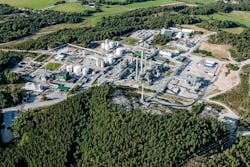Perstorp set to save more than one billion liters of fresh water yearly at plant in Sweden
(Malmö — Dec.19, 2022 — Perstorp Release) — Sustainable solutions provider Perstorp is investing in a unique project that will allow it to use wastewater from a nearby municipal treatment plant for production operations in Stenungsund, Sweden. This will save 1.1 billion liters of fresh water per year.
The project will enable Perstorp to secure the future supply of water for the Stenungsund plant. It also fits with the company’s long term sustainability ambition to become Finite Material Neutral.
“This is an important development of core technology for Perstorp,” said Anna Berggren, vice president sustainability. “We plan to implement it at more sites around the world in the future in our drive to reduce freshwater consumption. Fresh water scarcity is already a fact around the world. The chemical industry has a responsibility to reduce its use and find new solutions that can also support society as a whole.”
All Perstorp production plants use water for multiple purposes: as a solvent for chemical reactions, a carrier for products, a heat-transfer medium and for cooling, for example. One way of reducing consumption of fresh water is to purify and recycle wastewater. The Stenungsund project will enable wastewater from the water treatment plant run by the municipality to be further purified and reused at the Perstorp Oxo production plant.
The recycled water will also be used for production of renewable hydrogen via electrolysis for Perstorp’s game changing transition project Air, as well as for other strategic investments. “This project is a key enabler to combining business growth and sustainable development,” says Berggren.
Project Air is an initiative to transform the chemical industry towards climate neutrality. Perstorp Group and partner Uniper will produce sustainable methanol for chemical manufacturing using circular production methods.
